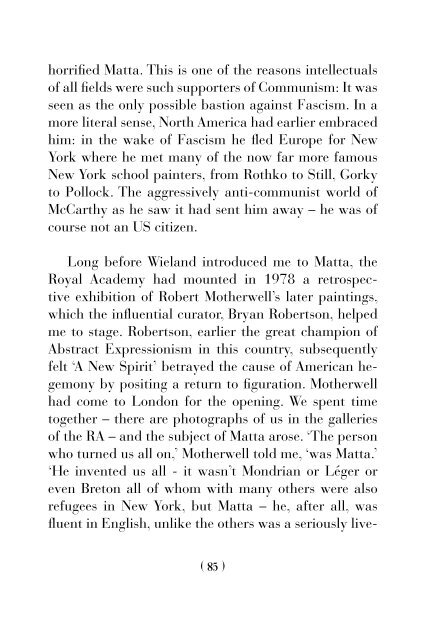Matta-Duchamp
Illustrated catalog featuring full page color illustrations and rare documentary photographs. Published by Galerie Gmurzynska in June 2018 to accompany a special cabinet exhibition at Art Basel 2018. The book includes texts by Professor Dawn Adès and Norman Rosenthal. It coincides with a broader re-evaluation of the importance of Matta internationally as well as of the influence of Duchamp on the work of 20th century artists. Edited and introduced by Krystyna Gmurzynska and Mathias Rastorfer. Essays by Dawn Adès and Norman Rosenthal. Historic interview excerpt by Robert Motherwell. 90 pages with 7 illustrations. Softcover. ISBN: 978-3-905792-09-6
Illustrated catalog featuring full page color illustrations and rare documentary photographs.
Published by Galerie Gmurzynska in June 2018 to accompany a special cabinet exhibition at Art Basel 2018. The book includes texts by Professor Dawn Adès and Norman Rosenthal. It coincides with a broader re-evaluation of the importance of Matta internationally as well as of the influence of Duchamp on the work of 20th century artists.
Edited and introduced by Krystyna Gmurzynska and Mathias Rastorfer.
Essays by Dawn Adès and Norman Rosenthal.
Historic interview excerpt by Robert Motherwell.
90 pages with 7 illustrations.
Softcover.
ISBN:
978-3-905792-09-6
Create successful ePaper yourself
Turn your PDF publications into a flip-book with our unique Google optimized e-Paper software.
horrified <strong>Matta</strong>. This is one of the reasons intellectuals<br />
of all fields were such supporters of Communism: It was<br />
seen as the only possible bastion against Fascism. In a<br />
more literal sense, North America had earlier embraced<br />
him: in the wake of Fascism he fled Europe for New<br />
York where he met many of the now far more famous<br />
New York school painters, from Rothko to Still, Gorky<br />
to Pollock. The aggressively anti-communist world of<br />
McCarthy as he saw it had sent him away – he was of<br />
course not an US citizen.<br />
Long before Wieland introduced me to <strong>Matta</strong>, the<br />
Royal Academy had mounted in 1978 a retrospective<br />
exhibition of Robert Motherwell’s later paintings,<br />
which the influential curator, Bryan Robertson, helped<br />
me to stage. Robertson, earlier the great champion of<br />
Abstract Expressionism in this country, subsequently<br />
felt ‘A New Spirit’ betrayed the cause of American hegemony<br />
by positing a return to figuration. Motherwell<br />
had come to London for the opening. We spent time<br />
together – there are photographs of us in the galleries<br />
of the RA – and the subject of <strong>Matta</strong> arose. ‘The person<br />
who turned us all on,’ Motherwell told me, ‘was <strong>Matta</strong>.’<br />
‘He invented us all - it wasn’t Mondrian or Léger or<br />
even Breton all of whom with many others were also<br />
refugees in New York, but <strong>Matta</strong> – he, after all, was<br />
fluent in English, unlike the others was a seriously live-<br />
( 85 )

















